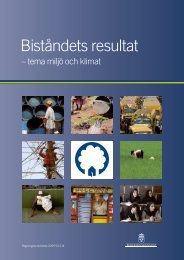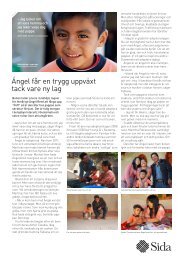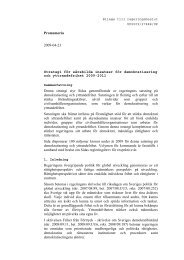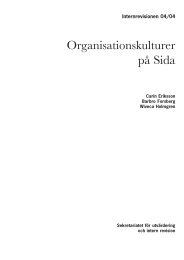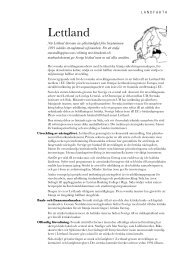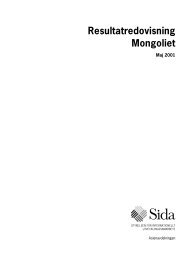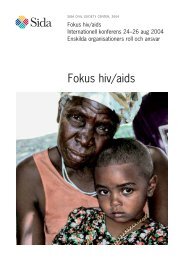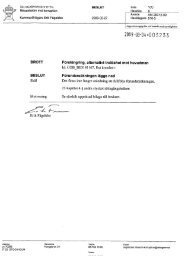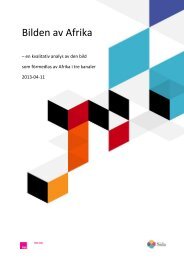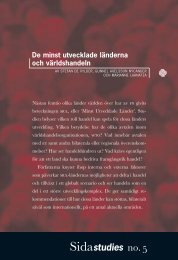Mid-Term Review of the AGIR Programme - Sida
Mid-Term Review of the AGIR Programme - Sida
Mid-Term Review of the AGIR Programme - Sida
You also want an ePaper? Increase the reach of your titles
YUMPU automatically turns print PDFs into web optimized ePapers that Google loves.
2 F I N D I N G S<br />
<strong>the</strong> <strong>AGIR</strong> programme has to produce results that are, in fact, a combination <strong>of</strong> partner’s<br />
results, <strong>the</strong>re needs to be a more consistent way to plan for <strong>AGIR</strong> to implement,<br />
monitor, and collect data on <strong>the</strong>se activities across <strong>the</strong> programme. As commented on<br />
by one intermediary staff member, ‘<strong>the</strong>re is not a consistent <strong>the</strong>ory <strong>of</strong> change’ shared<br />
by <strong>the</strong> intermediaries, which makes it difficult to actually plan for and document<br />
‘change’ within <strong>the</strong> programme. Reporting on its activities (and successes) is definitely<br />
improving within <strong>the</strong> <strong>AGIR</strong> programme, but <strong>the</strong>re is still much room for change.<br />
This would also help <strong>the</strong> visibility <strong>of</strong> <strong>the</strong> <strong>AGIR</strong> programme as its successes are now<br />
<strong>of</strong>ten seen by o<strong>the</strong>rs (external actors) as attributable to <strong>the</strong> work <strong>of</strong> specific CSOs or<br />
<strong>the</strong> intermediaries with whom <strong>the</strong>y work – ra<strong>the</strong>r than <strong>AGIR</strong>.<br />
The mid-term review team endorses <strong>the</strong> solutions outlined in <strong>the</strong> semi-annual report<br />
2012 by intermediaries to improve <strong>the</strong> level <strong>of</strong> outcomes <strong>of</strong> cross-cutting issues, particularly<br />
in gender, which constitute an important step forward, not only in terms <strong>of</strong><br />
probability <strong>of</strong> improving gender/cross-cutting results, but also in terms <strong>of</strong> <strong>the</strong> systematic<br />
joint planning (and budgeting) <strong>of</strong> common activities. <strong>AGIR</strong> intermediaries have<br />
decided to take a joint approach to improve outcomes in <strong>the</strong> area <strong>of</strong> addressing<br />
cross-cutting issues, which has been persistently weak. This joint approach will use a<br />
new ‘change-oriented’ gender training approach that was successfully tested by <strong>the</strong><br />
intermediaries in 2012. A gender technical group, comprised <strong>of</strong> representatives <strong>of</strong> <strong>the</strong><br />
four intermediaries was created in February 2012 to support <strong>the</strong> operationalisation <strong>of</strong><br />
this approach. Fur<strong>the</strong>rmore, intermediaries will scrutinise partner plans from a gender<br />
and cross-cutting issues perspective in order to better track and identify partner results.<br />
2.4.3 Networking Mechanisms for <strong>AGIR</strong> CSO Partners<br />
As noted by some interviewees, taking good-donorship principles into account means<br />
that existing networks and coalitions should be focused and streng<strong>the</strong>ned. The priority<br />
<strong>of</strong> <strong>the</strong> programme, it is felt, should be to facilitate and create opportunities for this<br />
streng<strong>the</strong>ning process, ra<strong>the</strong>r than to promote new networks. However, <strong>the</strong>se principles<br />
are not in line with current programme strategies and <strong>the</strong> intermediaries still<br />
have to devise an approach to support networks, since <strong>the</strong> ambition is to create networks<br />
that cross-cut intermediaries and <strong>the</strong>matic areas. Some partners raised concerns<br />
about <strong>the</strong> difficulties <strong>of</strong> networking, managing and monitoring <strong>the</strong> work <strong>of</strong> networks<br />
and <strong>the</strong>ir added-value is being partially addressed; and in this regard Oxfam<br />
has produced a small explicative brochure on networks. A study on how change happens<br />
has been also commissioned to this end.<br />
Networking within <strong>the</strong> <strong>AGIR</strong> programme is generally perceived as weak. Although<br />
some organisations have created networks and linkages within <strong>the</strong> <strong>AGIR</strong> programme,<br />
<strong>the</strong>se are mainly vertical ones (including partners <strong>of</strong> <strong>the</strong> same intermediary), with a<br />
limit to networks or linkages that cross-cut sub-programmes. According to many<br />
<strong>AGIR</strong> partners, opportunities for internal networking are limited to training sessions<br />
and joint meetings. The lack <strong>of</strong> a clear mechanism for partnership is also perceived as<br />
an obstacle to more effective partnership. For example, <strong>the</strong> Electoral Observatory<br />
49




